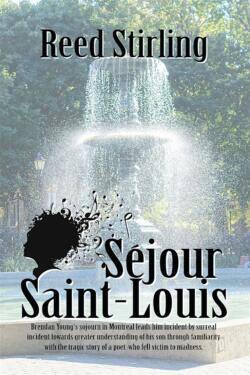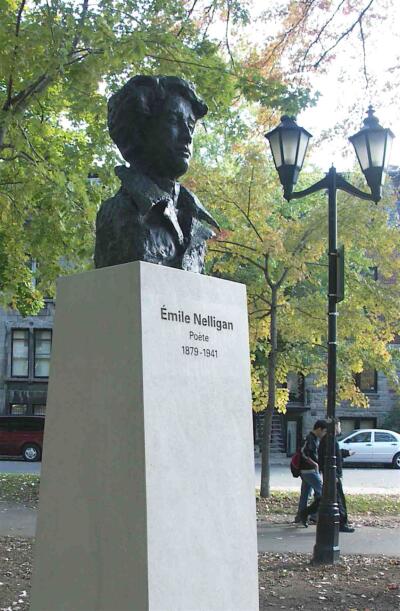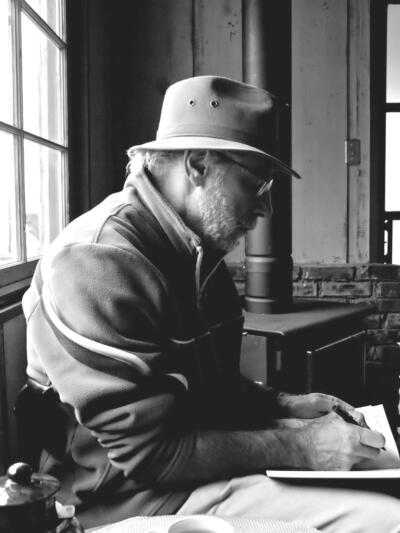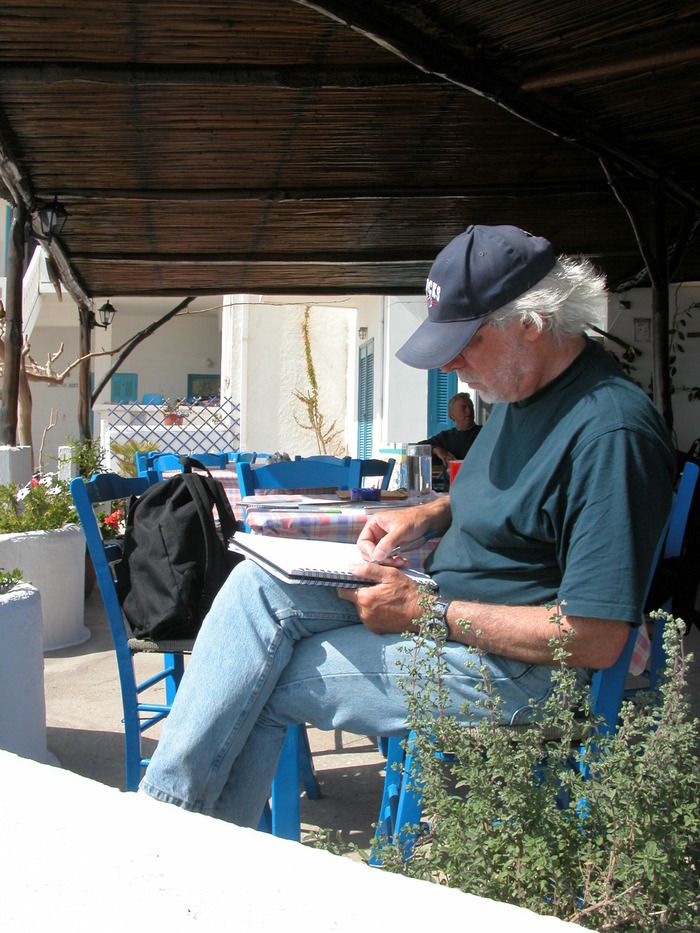1599 Pilgrimage to the bust of Nelligan
Séjour Saint-Louis
by Reed Stirling
Airdrie, Alberta: BWL [Books We Love] Publishing, 2021
$22.00 / 9780228617488
Reviewed by Ginny Ratsoy
*
 Cowichan Bay painter and writer Reed Stirling has published three works in as many years, following up a literary mystery and a “fictional memoir” with an atmospheric novel that is heavily and overtly influenced by 19th Century dark Romantic writers such as Baudelaire and Poe.
Cowichan Bay painter and writer Reed Stirling has published three works in as many years, following up a literary mystery and a “fictional memoir” with an atmospheric novel that is heavily and overtly influenced by 19th Century dark Romantic writers such as Baudelaire and Poe.
Our narrator-protagonist, Calgary oil business man Brendan Young, returns to Montreal, the city of his youth, for a reunion at Yamaska College, which he attended for one year. Although he can taste his romantic past during his flâneur-like wanderings around the city, he cannot shake his present — as the father of three — including an apparently dissolute son, Eliot — and husband to Elinore, a French-Canadian teacher decidedly disenchanted with their relationship.

The readerly advantages and disadvantages of a first-person narrator are in full force in Séjour Saint-Louis. Although we appreciate the immediate access to the protagonist’s thoughts and feelings, we may be frustrated by the limitations of the point of view. Is Eliot really so disturbing and disappointing? Perhaps Elinore is the one with whom we should side, given Brendan’s tippling, intransigence and obsessiveness?
In keeping with the impressionistic style of the novel, Stirling opts for scenes, rather than chapters — fifteen, to be precise. The novel divides (roughly) into three acts: first, Brendan’s return to Montreal and the eponymous hotel where he and Elinore honeymooned interspersed with perambulations through Montreal, thick with local colour and redolent with memory; second, his meeting (both outdoors and in an Irish pub) with best college buddy Ron Desbiens; and finally the reunion itself, set in an art-laden mansion replete with copious quantities of a magical “e-lixar” that encourages truth telling but is curiously free of hangover effects. Although the novel as a whole has distinctly surrealist undertones, the reunion setting is particularly through-the-looking glass, as Brendan notes.

The arrival, hotel room stay and perambulations illuminate Brendan’s anxiety — about both familial discord and the upcoming reunion — as well as his enchantment with Montreal, past and present. A keen observer of art and religious iconography in all of their manifestations, he is particularly drawn to recurring images of Montreal symbolist lyrical poet Émile Nelligan (1879-1941) known for his preoccupation with the passage of time, a hallucinatory world view, and the mental problems that plagued him and resulted in institutionalization for over a decade before his death.
The bust of Nelligan, seemingly appearing out of nowhere, marks Brendan’s initial meeting with Desbiens, and the two mull over its countenance as they make their way to the Irish pub on Main. Over several Guinness rounds, the two catch each other up. Brendan is particularly forthcoming about his misgivings about his marriage and, not unrelated, about Elliot, sharing the sense that the spirits of mother and son are pursuing him, a sensation he ascribes to his recent reading of a Baudelaire story in an anthology a young student left on the train to Montreal. The talk then turns to reunion anticipation, complete with detailed dissections of individual classmates.
When the two set out the following day, they soon join one of those cronies, watercolourist Cat Consedine, who points out the Nelligan bust and leads them to the reunion mansion, cataloguing its many outstanding exterior and interior features, and informing them its owners, two of their old classmates, are footing the entire bill for the celebration.

Against a backdrop of exceptional works of art (often depicting Greek mythology) bolstered by live chamber and classic rock music, exquisite culinary delicacies, and the enigmatic e-lixar, Brendan becomes re-acquainted with Yamaska colleagues, enjoying the reminiscences, philosophizing and aesthetics, but unable to shake the sense he is being stalked. Inevitably, Brendan turns the talk to Elliot when he encounters those with professional credentials that might provide enlightening analysis. However, diagnoses such as Borderline Personality Disorder provide our protagonist with insufficient satisfaction. It is only when he encounters a clarifier of all matters in his youth, literature professor Emery St James Montesquieu, that Brendan makes great strides in his quest to unravel the workings of his son. That path is indirect: via Baudelaire (whose work Montesquieu is familiar with primarily because it was the specialty of his partner, who was killed in 9/11) the two wend their discussion to Nelligan, and as Montesquieu illuminates details of the poet’s life Brendan sees remarkable parallels to his son’s life — from deep religious convictions and extreme closeness to mothers to emotionally detached fathers.
The denouement wraps up things neatly. Brendan Young’s journey through the past provides him a window into the young man he was that year at Yamaska College, but, as importantly, it also illuminates who he is at present and points the way ahead. As he makes his final pilgrimage to the bust of Nelligan, after making symbolic gestures to right his own wrongs, he feels cleansed and enlightened.
Despite sometimes stilted language and woefully inadequate attention to the finer details of copy editing, Séjour Saint-Louis is a charming, eccentric read, infused with a passion for the manifold pleasures of art and a keen eye for the foibles of humankind.
*

Ginny Ratsoy is Professor Emerita at Thompson Rivers University. Her scholarly publications focus on Canadian fiction, theatre, small cities, third-age learning, and the scholarship of teaching and learning. In addition to counteracting ageism by maintaining a growth mindset through freelance writing and community engagement, she promotes later-life learning through her involvement as a board member, instructor, and coordinator for the Kamloops Adult Learners Society. Her latest course for KALS, “A Taste of Margaret Atwood,” saw students of diverse backgrounds and ages deeply engaged in study and discussion of one of Canada’s most renowned public intellectuals. Editor’s note: Ginny Ratsoy has recently reviewed books by Maria Tippett, Gillian Ranson, Jo Owens, Iona Whishaw, Mark Bulgutch, and Ron Base & Prudence Emery for The British Columbia Review.
*
The British Columbia Review
Publisher and Editor: Richard Mackie
Formerly The Ormsby Review, The British Columbia Review is an on-line book review and journal service for BC writers and readers. The Advisory Board consists of Jean Barman, Wade Davis, Robin Fisher, Barry Gough, Hugh Johnston, Kathy Mezei, Patricia Roy, Maria Tippett, and Graeme Wynn. Provincial Government Patron (since September 2018): Creative BC. Honorary Patron: Yosef Wosk. Scholarly Patron: SFU Graduate Liberal Studies.
“Only connect.” – E.M. Forster

6 comments on “1599 Pilgrimage to the bust of Nelligan”
An excellent review. Thorough.